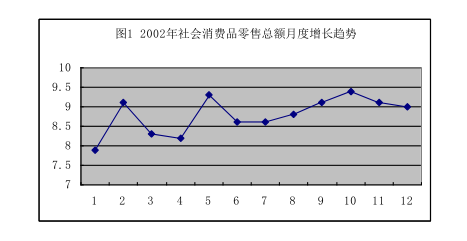Features of China’s Consumer Goods Market and its Development Trend
Jun 02,2003
Wang Wei
Research Report No 023, 2003
I. The Basic Features of the Development of Consumer Goods Market in 2002
1. The consumer goods market in general maintained a steady growth in the year, but the growth rate declined to some extent.
In the first 11 months of 2002, the total retail sales of consumer goods was 4,088.6 billion yuan, up by 8.8 percent over the same period of the previous year. But the growth rate was 1.3 percentage points lower than a year earlier. If the price factor is taken into account, the actual growth was 9.6 percent. A look at the monthly growth trend in the year indicates that there were considerable fluctuations, with February, May and October being the three growth peaks (see chart 1).
Chart 1 Monthly Growth Trend of Total Retail Sales of Consumer

Data source: National Bureau of Statistics: Monthly Report on China’s Economic Prospect, Issues 1-11, 2002.
In 2002, the growth rate of the total social retails of consumer goods continued to be higher than that of the gross domestic product (GDP). The gap was 0.8 percentage points, which was 2 percentage points lower than the 2.8 percentage points registered in the previous year. It is estimated that the contribution rate of the domestic consumption demand to the economic growth was 46 percent, down about 5 percentage points from the level of the previous year.
2. The market prices of consumer goods continued to move at a low level
Since November 2001 and especially since the beginning of 2002, the general price level of residents’ consumption has demonstrated a new round of declines, posting a negative growth for 13 months running. In the first 11 months of 2002, the national consumer price index (CPI) declined accumulatively by 0.8 percent. In particular, the fall in April was 1.3 percent, the most dramatic dive since September 1999 (a 1.3 percent dip was registered in August 1999). The retail prices of commodities having comparatively greater impact on the performance of the consumer goods market went down by 1.4 percent in the first 11 months of 2002, 0.8 percentage points higher than in the previous period. Of the 14 categories of commodities, only western and traditional Chinese medicines, publications and fuels saw their prices climbing slightly. All the other 11 categories charted a declining trend. Specifically, daily necessities, household appliances, jewelry and food reported more drastic dips, respectively at 21 percent, 6 percent, 5.5 percent and 4.2 percent.
3. The general pattern of supply exceeding demand continued to develop.
According to the State Economic and Trade Commission’s tracking over the supply-demand trend of more than 600 main commodities, 86.3 percent of commodities reported supply exceeding demand in the first half of 2002, which was 3.3 percentage points higher than that in the second half of 2001. The proportion of the commodities that registered a general supply-demand balance went down to 12 percent from the 17 percent in the second half of 2001. Compared with the first half of 1999, the proportion of the commodities that registered supply surpassing demand in the first half of 2002 rose 14.1 percentage points, while that of the commodities that struck a supply-demand balance fell by 13.9 percentage points. It is clear that since 1999, the Chinese economy’s structural contradiction characterized by supply surpassing demand has been developing and has reached a critical point.
4. Structural disparities still existed in the development of the consumer goods market.
First, the widening of the development gap between the urban and rural areas has somewhat eased. In 2002, the consumer goods market in the urban area continued to maintain a fairly fast growth. The total retail sales for the whole year was 2354.34 billion yuan, up by 9.9 percent year-on-year. However, the growth rate was 1.6 percentage points lower. The performance of the consumer goods market at or below the county level was relatively stable, with a growth rate wandering between 6 percent and 7 percent. The total retail sales of consumer goods in the rural market at or below the county level was 1405.18 billion yuan, up by 6.8 percent over the previous year, but the growth rate was 0.9 percentage points lower. The development gap between the urban and rural markets was 3.1 percentage points, which was 1.1 percentage points smaller than that of the previous year. Their contribution rates to the growth of the total social retails of consumer goods nationwide were respectively 71.1 percent and 28.9 percent.
Second, the development gap between different trades in the consumer goods market was further widened. In terms of the structure of trades, the total retail sales of consumer goods in the wholesale and retail sector, the catering sector and other trades in the first 10 months of 2002 were respectively 9.1 percent, 16.4 percent and 3.4 percent higher than that in the same period of the previous year. The contribution rates of the wholesale and retail sector and the catering sector to the growth of the total retail sales of consumer goods nationwide were respectively 70.4 percent and 21.6 percent. The above figures indicate that the gap between the development rates of the retail sales of consumer goods in different trades was nearly 13 percentage points, which was 2 percentage points wider than that in the previous year.
5. The new hot spots of consumption and new fields of consumption continued to maintain a rapid growth.
Since the beginning of 2002, the new hot spots of consumption and new areas of consumption that emerged as a result of the structural upgrading of Chinese residents’ consumption and the rise of the consumption level continued to maintain a rapid growth. With a further expansion of the market scale, they have become important supporting forces for the development of the consumer goods market.
...
If you need the full context, please leave a message on the website.














